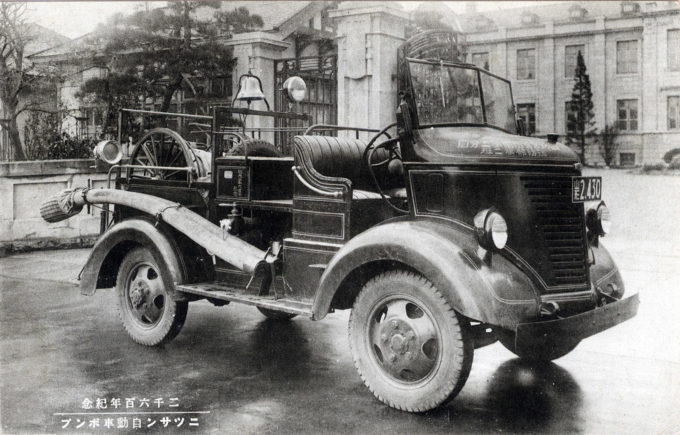
Nissan pumper fire truck, c. 1940, built in commemoration of the 2600th Founding Anniversary. The pumper was fabricated atop a Datsun Type 95 mini-truck chassis, with the body modeled after the standard U.S. Federal COE (cab-over-engine) design. The following year, 1941, Nissan would introduce the longer (17.5′ vs. 11′) and heavier Type 180 truck chassis for fire-fighting trucks.
See also:
Dezome-shiki (“First event”), New Year’s Day, c. 1910 & 1960.
“Twenty-five years ago [1888] there was no water works in any part of Japan. Neither was there any fire-extinguishing apparatus, anything even remotely approaching fire engine, if one exclude the hand-pump with wooden tube-like hose, which sends feeble jet of water a few yards away. Practically with no aid the firemen combated with roaring, devastating fires, which not infrequently reduced to ashes a part, or the whole, of a city or town.
“… The modern Japanese firemen, whom one finds every day in the street, clad in khaki uniform and wearing a round German cap, is a disappointing, nondescript creature. He has none of the dash and go of the old hikeshi, who was an idol with certain professionals, notably, geisha and female teachers of samisen music. There were various reasons for this romantic side of the hikeshi‘s career, which admit of amplification .
“Talking about the modern firemen, it is well to mention that they are recruited from all classes, who are willing to serve with Police Fire Brigade for a number of years. They undergo training like a common soldier, are taught the proper handling of fire engines, and for the rest they are expected to do their duty connected with extinguishing fire. The modern firemen are as apart from the hikeshi … as the water is from the fire.
“… With the establishment of modern fire brigade, the picturesque hikeshi disappeared, though their descendants are still seen in the much changed laborers engaged in erecting scaffolding for buildings, etc. Still fondly they cling to the time-honored titles of their old companies, and the public tolerates it as though out of respect for their past glory.”
– “The Fireman: His Chivalrous Achievements in Days Gone By”, by “13+13”, The Musashino, August 1913


Pingback: Fire Brigade Parade commemorative postcards, New Year’s Day, Tokyo, 1912. | Old Tokyo